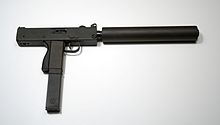MAC-11
| MAC-11 | |
|---|---|
 M11A1 submachine gun (without a magazine) and the stock folded. | |
| Type | Machine pistol |
| Place of origin | United States |
| Service history | |
| Wars | 2013 Lahad Datu standoff |
| Production history | |
| Designer | Gordon B. Ingram[1] |
| Designed | 1972 |
| Produced | 1972-present |
| Specifications | |
| Mass | 1.59 kg (3.50 lbs) |
| Length | 248 mm (531 mm stock extended) (9.76 in/20.90 in) |
| Barrel length | 129 mm |
| Cartridge | .380 ACP |
| Caliber | 9mm |
| Action | Straight Blowback |
| Rate of fire | 1200 /min[1] |
| Muzzle velocity | 980 ft/s |
| Effective firing range | 50 m |
| Feed system | 16 or 32-rounds box magazine[1] |
| Sights | Iron sights |
The Ingram MAC-11 (Military Armament Corporation Model 11) is a subcompact machine pistol developed by American gun designer Gordon Ingram at the Military Armament Corporation (MAC) during the 1970s.[2] The weapon is a sub-compact version of the Model 10 (MAC-10), and is chambered to fire the smaller .380 ACP round.[2]
This weapon is sometimes confused with the Sylvia & Wayne Daniels M-11/9 or the Vulcan M-11-9, both of which are later variants of the MAC chambered for 9 mm Luger Parabellum cartridge.[3][4] Cobray also made a .380 ACP variant called the M12.[5]
Sound suppressor
A specific suppressor was developed for the MAC-11, which used wipes as baffles, instead of the reflex baffles that Mitchell Werbell III created for the MAC-10. Though wipes are less durable than reflex baffles, they had the advantage of proving quieter for the MAC-11. The suppressor is 224mm in length and is covered with Nomex-A heat-resistant material.[1]
Operation
Like the larger M-10, the M-11 has open sights with the rear pinhole sight welded to the receiver. These sights are for use with the folding stock, as using them without the stock is nearly useless because of the initial jump of the weapon due to its heavy, open-bolt design. The M-11A1 also has two safety features which are also found on the Model 10A1. The charging handle rotates to the 90 degrees to lock the bolt in the forward position thus preventing the weapon from being cocked. The second safety is a slider which is pushed forward to lock the trigger, which in turn pins the bolt to the rear (cocked) position. This prevents the weapon from discharging even when dropped, which is not uncommon with an open-bolt design.
Performance

The rate of fire of the M-11A1 is one of the biggest complaints on the firearm. Listed as approximately 1200 rpm (rounds per minute),[4] the MAC-11 is capable of emptying the entire 32-round magazine in less than two seconds, which many users view as a setback.[6] Rate of fire will also vary depending on which grain of ammo is used.
Acceptance
The M-11 is the least common version in the MAC family of firearms. This is mostly due to the .380 ACP round, which has a muzzle velocity of approximately 950 ft/s (290 m/s) and 200 ft⋅lbf (270 J) of energy, and is widely considered to have insufficient stopping power. At the MAC-11's high cyclic rate, extreme trigger discipline is required to discharge short bursts, which are required for combat expediency. Without proper training, the natural tendency of the inexperienced shooter is to hold down the trigger, discharging the entire magazine in little more than two seconds, often with poor accuracy due to recoil.
Manufacturers
MAC-type submachine guns and semi-automatic pistols were first manufactured by the Military Armament Corporation, and later by RPB Inc., Sylvia/Wayne Daniel Inc., Cobray, Jersey Arms, Leinad, MasterPiece Arms,[4] and Vulcan.
See also
References
- ^ a b c d Hogg, Ian (1989). Jane's Infantry Weapons 1989-90, 15th Edition. Jane's Information Group. p. 117. ISBN 0-7106-0889-6.
- ^ a b Jack Lewis (2004). Assault Weapons. Krause. p. 76.
- ^ Jones, Richard (2009). Jane's Infantry Weapons 2009-2010. Jane's Information Group. p. 139. ISBN 0-7106-2869-2.
- ^ a b c Robert E. Walker (2012). Cartridges and Firearm Identification. CRC Press. pp. 216, 241, 322. ISBN 1466502061.
- ^ Jerry Lee (2011). The Gun Digest Book of Guns & Prices 2011. Gun Digest Books. p. 235. ISBN 1440235430.
- ^ "Ingram MAC Model 10 / M10 and Model 11 / M11 submachine guns (USA)". Official site.
